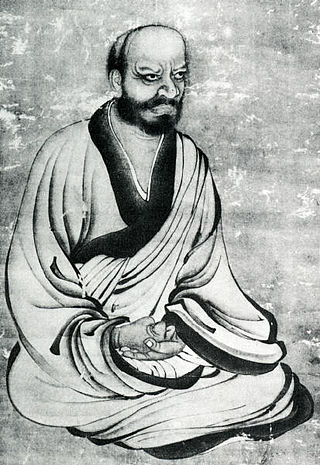
Linji Yixuan was the founder of the Linji school of Chán Buddhism during Tang dynasty China.

Myōan Eisai/Yōsai was a Japanese Buddhist priest, credited with founding the Rinzai school, the Japanese line of the Linji school of Zen Buddhism. In 1191, he introduced this Zen approach to Japan, following his trip to China from 1187 to 1191, during which he was initiated into the Linji school by the master Hsü an. It is also said that he popularized green tea in Japan, following this same trip. He was also the founding abbot of Japan's first Zen temple Shōfuku-ji and Kennin-ji. He is often known simply as Eisai/Yōsai Zenji (栄西禅師), literally "Zen master Eisai".

The Ōbaku-shū (黄檗宗) is one of several schools of Zen in Japanese Buddhism, in addition to Sōtō and Rinzai.

Ōbaku-san Manpuku-ji is a Buddhist temple located in Uji, Kyoto. It is the head temple of the Japanese Ōbaku Zen sect, named after Wanfu Temple in Fujian, China. The mountain is likewise named after Mount Huangbo, where the Chinese temple is situated.

The Rinzai school is one of three sects of Zen in Japanese Buddhism. The Chinese Linji school of Chan was first transmitted to Japan by Myōan Eisai. Contemporary Japanese Rinzai is derived entirely from the Ōtōkan lineage transmitted through Hakuin Ekaku (1686–1769), who is a major figure in the revival of the Rinzai tradition.
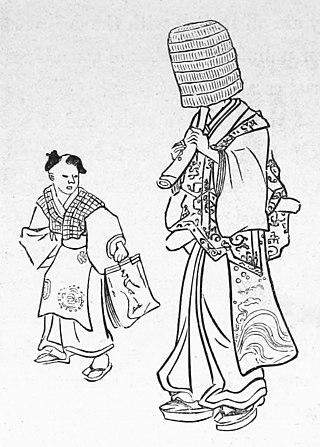
Fuke-shū or Fuke Zen was, according to the legend, a distinct and ephemeral derivative school of Zen Buddhism that originated as an offshoot of the Rinzai school during the nation's feudal era, lasting from the 13th century until the late 19th century. There are however no historical records to support this.

Zhengding, originally Zhending, is a county in southwestern Hebei Province, North China, located approximately 260 km (160 mi) south of Beijing, capital of China. It is under the administration of the prefecture-level city of Shijiazhuang, the capital of the province, and has a population of 594,000. Zhengding has been an important religious center for more than 1,000 years, from at least the times of the Sui dynasty to the Qing dynasty. It is the founding place of several major schools of Chan Buddhism. However, many former religious building complexes have been severely damaged throughout history. A noted temple is the Longxing Monastery, where the historical building ensemble has been preserved almost intact. Furthermore, four famous pagodas, each with its own architectural style, are still standing.

The Jogye Order, officially the Jogye Order of Korean Buddhism, is the representative order of traditional Korean Buddhism with roots that date back 1200 years to the Later Silla National Master Doui, who brought Seon and the practice taught by the Sixth Patriarch, Huineng, from China around 820 CE. The name of the Order, Jogye, was adopted from the name of the village where Patriarch Huineng's home temple, Nanhua Temple, is located,.

The Fanjingshan or Mount Fanjing, located in Tongren, Guizhou province, is the highest peak of the Wuling Mountains in southeastern China, at an elevation of 2,570 m (8,430 ft). The Fanjingshan National Nature Reserve was established in 1978 and designated a UNESCO Biosphere Reserve in 1986. Fanjingshan is a sacred mountain in Chinese Buddhism, considered to be the bodhimaṇḍa of the Maitreya Buddha. It became a UNESCO World Heritage Site in 2018.
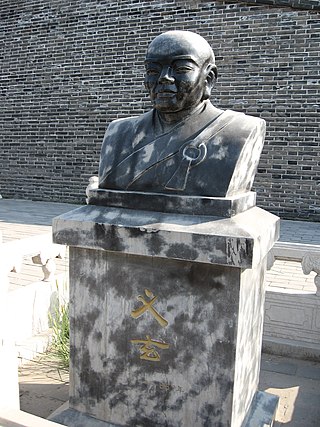
The Línjì school is a school of Chan Buddhism named after Linji Yixuan. It took prominence in Song China (960–1279), spread to Japan as the Rinzai school and influenced the nine mountain schools of Korean Seon.
Zen is a school of Mahayana Buddhism that originated in China during the Tang dynasty, known as the Chan School, and later developed into various sub-schools and branches. From China, Chán spread south to Vietnam and became Vietnamese Thiền, northeast to Korea to become Seon Buddhism, and east to Japan, becoming Japanese Zen.
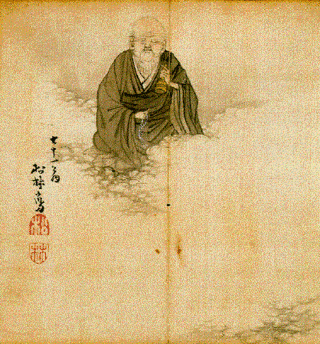
Zhenzhou Puhua, also called P'u-k'o, and best known by his Japanese name, Fuke, was a Chinese Chán (Zen) master, monk-priest, wanderer and eccentric, mentioned in the Record of Linji. Fuke was used to create a legend for the komusō samurai-monks that appeared in Edo-period Japan. They used their self-named Fuke Zen to establish a constructed connection to Japanese Rinzai Zen Buddhism in the 17th or 18th century. The legend is written in the Kyotaku Denki (虚鐸伝記), first published in 1795 together with a "Japanese Translation" of the "original" in literary Chinese (kanbun). The original text may have been written in the middle of the 17th century, but there are no historic texts to support this. For the komusō (虚無僧) samurai-monks, he was considered the traditional antecedent—at least in spiritual, mythological, or philosophical terms—of their order, which was formally established in Edo Japan. It is possible that the ideological roots of the sect derived from the Rinzai poet and iconoclast Ikkyū and the monk Shinchi Kakushin (心地覺心) who traveled to and from China and Japan in the 13th century. Still, according to some accounts, the sect is simply a more direct derivative of the Rinzai school and its teachings.

Chan, from Sanskrit dhyāna, is a Chinese school of Mahāyāna Buddhism. It developed in China from the 6th century CE onwards, becoming especially popular during the Tang and Song dynasties.
The Five Houses of Chán were the five major schools of Chan Buddhism that originated during Tang China. Although at the time they were not considered formal schools or sects of Buddhism, they are now regarded as important schools in the history of Chán Buddhism. Most Chán lineages throughout Asia and the rest of the world originally grew from or were heavily influenced by the original five houses of Chán.

Seon or Sŏn Buddhism is the Korean name for Chan Buddhism, a branch of Mahāyāna Buddhism commonly known in English as Zen Buddhism. Seon is the Sino-Korean pronunciation of Chan an abbreviation of 禪那 (chánnà), which is a Chinese transliteration of the Sanskrit word of dhyāna ("meditation"). Seon Buddhism, represented chiefly by the Jogye and Taego orders, is the most common type of Buddhism found in Korea.
Zen lineage charts depict the transmission of the dharma from one generation to another. They developed during the Tang dynasty, incorporating elements from Indian Buddhism and East Asian Mahayana Buddhism, but were first published at the end of the Tang.
Xuefeng Yicun was a Chinese Chan-master who was influential during the Tang dynasty. The Yunmen school and Fayan school originated with descendants of his lineage.
The Zen tradition is maintained and transferred by a high degree of institutionalisation, despite the emphasis on individual experience and the iconoclastic picture of Zen.
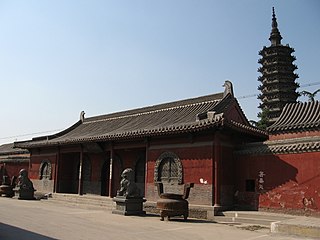
Linji Temple is a Buddhist temple located in Zhengding Town of Zhengding County, Hebei, China. In the mid-Tang dynasty (618–907), Linji Yixuan founded the Linji school, which eventually became one of the five major schools of Buddhism in China. In the Song dynasty (960–1276), two Japanese monks Eisai and Shuniyo introduced Linji school to Japan. Linji Temple is the cradle of Linji (Rinzai) school of both Chinese and Japanese Buddhism. The temple was added to National Key Buddhist Temples in Han Chinese Area's list in 1983. The eldest thing in the temple is the Chengling Stupa, which still preserves the architectural style of the Liao and Jin dynasties (916–1234).













